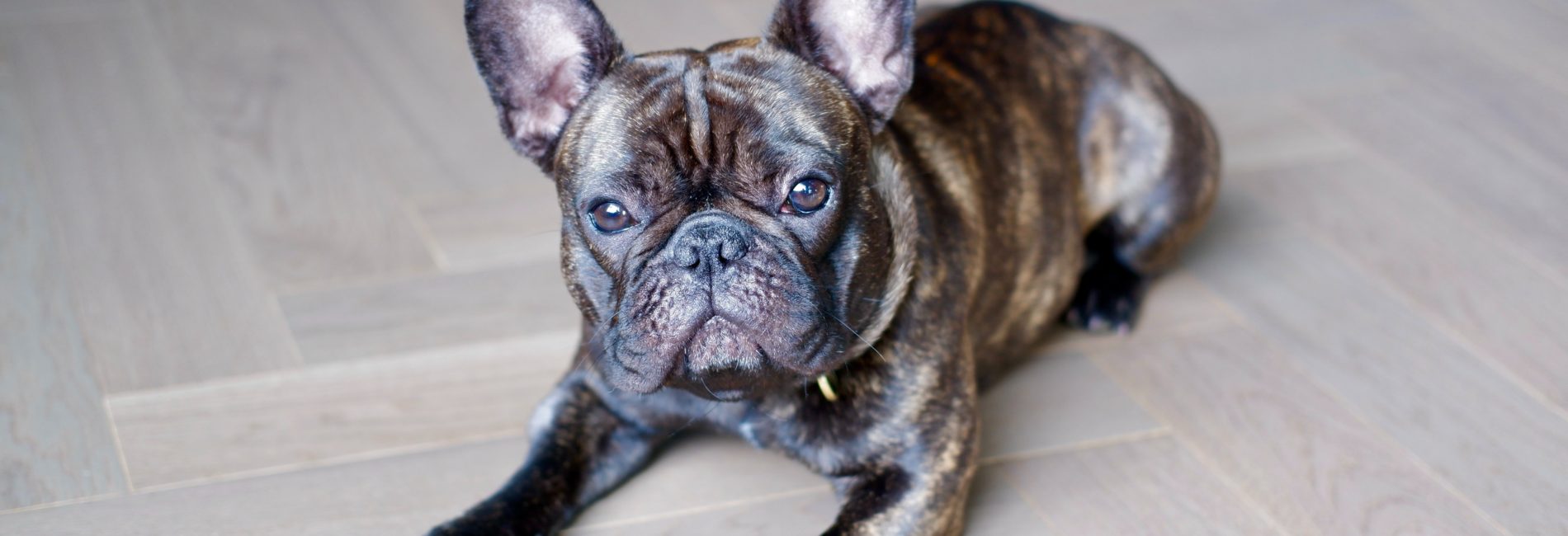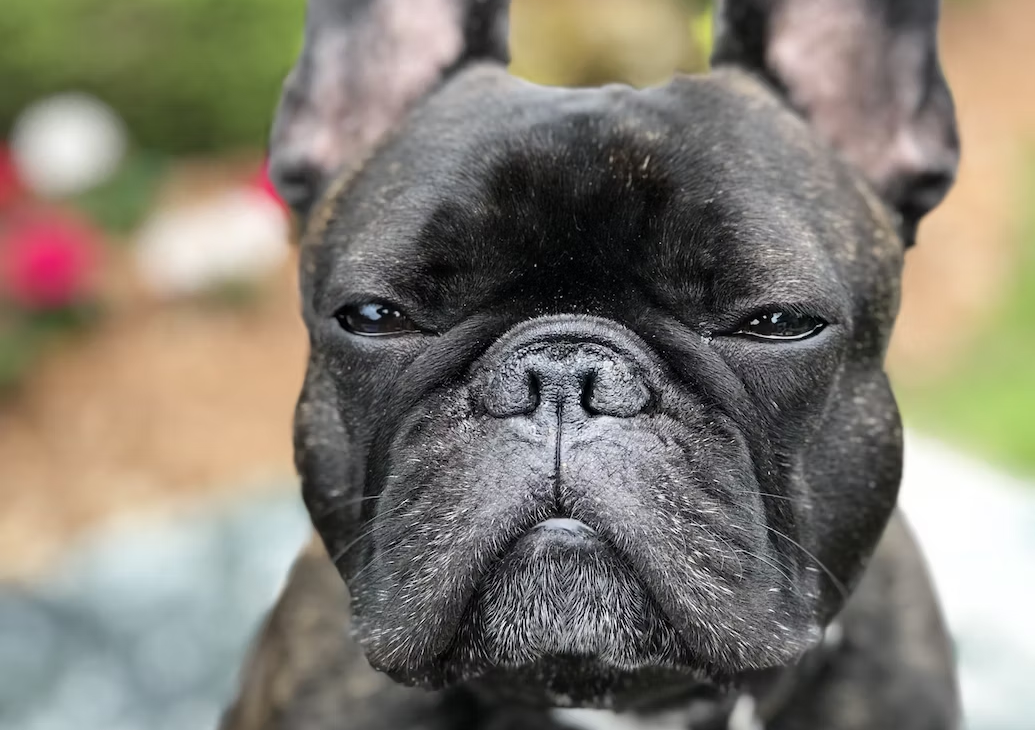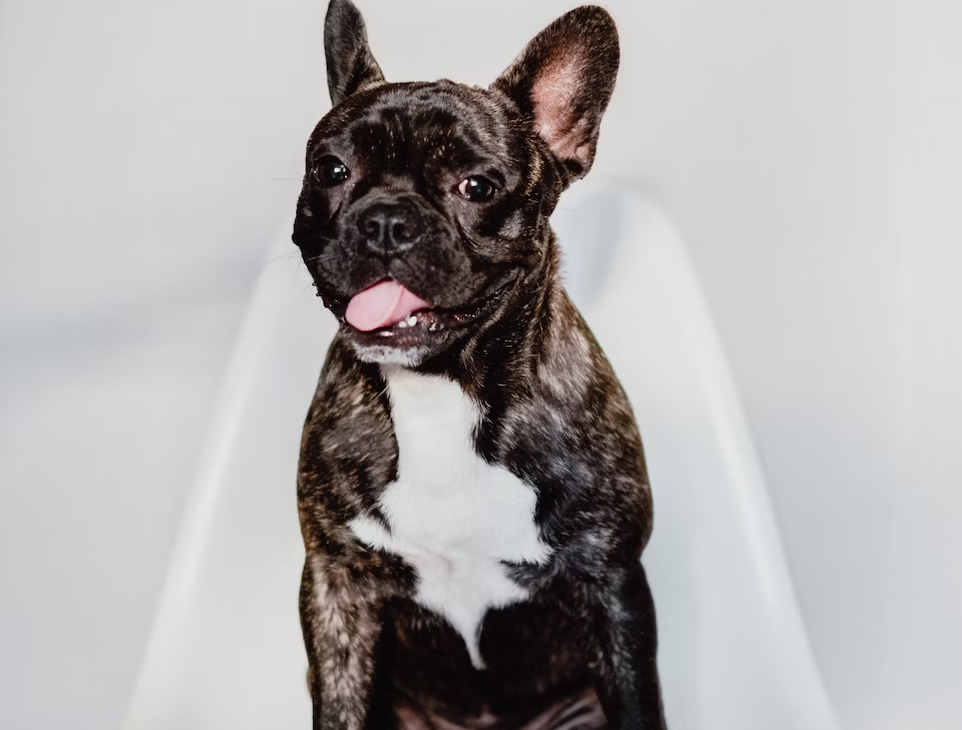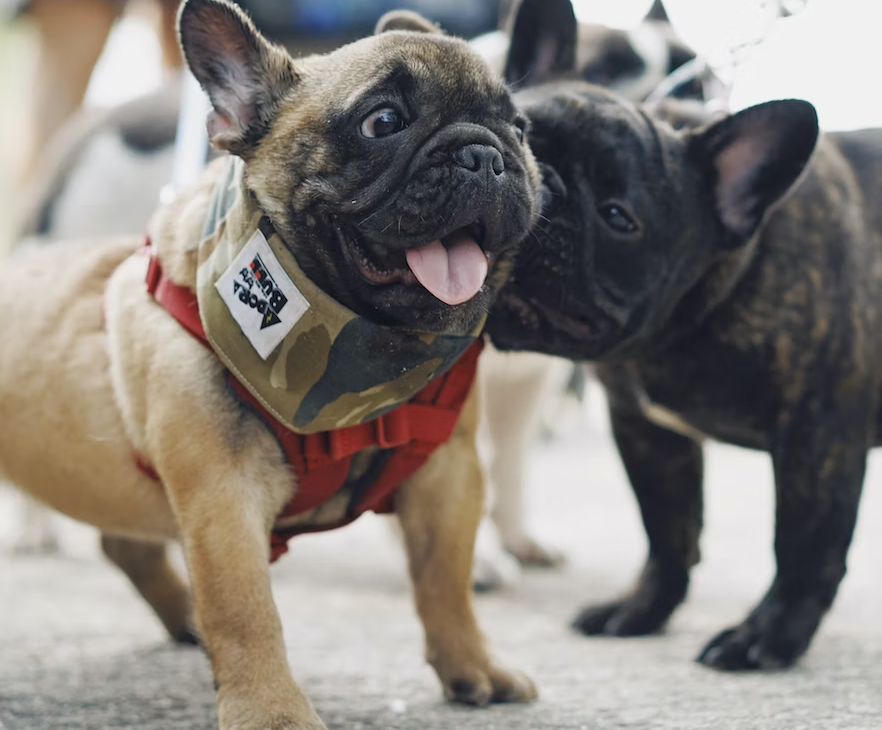
Brindle French Bulldogs (Blue, Black, Reverse, Lilac & More)
Brindle is a trending French Bulldog coat pattern that comes in many color and intensity variations such as blue brindle, black brindle, reverse brindle, lilac brindle, chocolate brindle and many more. The striking coat pattern of a Brindle French Bulldog paired with their affectionate temperament makes them highly sought after, fetching really high prices!
If you are interested in Brindle French Bulldogs keep reading this article to find out the all the answers to your questions about this coat type!
What Is A Brindle French Bulldog?
A Brindle French Bulldog refers to a specific coat pattern that is characterized by stripes over a base color. In most cases, the color of a Brindle French Bulldog is cream or fawn with dark stripes however there can be variations to this pattern as well as its intensity. The stripes are usually black, brown or tan and are located on a Frenchie’s back, sides, legs and face.
Brindle French Bulldog Genetics
The genes that are involved in the brindle coat include the K locus and the Agouti signaling protein (ASIP) gene. The Agouti signaling protein gene is what determines the base color of the coat which is usually cream or fawn. The K locus (also known as the dominant black locus) is in charge of the intensity and distribution of the brindle pattern. Within the K locus is the ‘kbr’ allele which is in charge of the brindle coat pattern and is dominant over the ‘ky’ gene.
Is Brindle A Dominant Gene In French Bulldogs?
The brindle coat results from a the brindle ‘kbr’ allele which is a dominant gene. This means that a French Bulldog only needs to carry one copy of ‘kbr’ to inherit the brindle coat pattern. Frenchies that have one copy of the brindle allele and one copy of the non-brindle allele (kbr/ky) as well as ones that are homozygous for the brindle allele (kbr/kbr) will have the brindle coat pattern.
Are Brindle French Bulldogs Rare?
Brindle French Bulldogs are not rare. In fact, brindle is a very common coat pattern and is just as common as coats like cream, fawn and pied. Brindle is a recognized coat color by many breed standards including the American Kennel Club (AKC) which goes to show that it is not a rare coat pattern.
While brindle is not considered to be a rare coat pattern, there can be variations in the brindle coat and some are more common than others. Some Frenchies have a very pronounced brindle pattern while others have a very faint pattern. Strong brindle coats where there are well-defined stripes tend to be more common than pale or diluted ones.
It’s also important to note that the commonality of the brindle coat can depend on geographic location. In certain regions, breeders focus on creating the brindle coat while in others it is not as common.
Kennel Club Recognition
Brindle French Bulldogs are recognized by many kennel clubs around the world. Most notably, they are recognized by the four major clubs including the American Kennel Club (AKC), the Kennel Club (UK) in the United Kingdom, the Canadian Kennel Club (CKC) and the Federation Cynlogique Internationale (FCI) in Belgium.

Types Of Brindle French Bulldog
Reverse Brindle French Bulldog
“Reverse Brindle” is an informal term used to describe a brindle pattern where the base color seems to be darker and the stripes are lighter – the opposite of a standard Brindle French Bulldog that has a light base coat with dark stripes.
In reality, there is no such thing as a true Reverse Brindle French Bulldog. They rather just have a different distribution of color intensity. They appear to have a darker striped pattern on a lighter background.
Blue Brindle French Bulldog
A Blue Brindle French Bulldog has a diluted brindle coat. The base coat is a bluish-grey and the brindle stripes are in a darker shade of grey. For a Blue Brindle French Bulldog to be produced both the brindle gene and the ‘blue dilution’ gene must be present, otherwise known as the D locus.
The D locus affects the eumelanin pigment in a French Bulldog’s coat. Eumelanin is a pigment that is responsible for dark brown or black coats and when eumelanin is diluted, the result is a coat with a bluish-grey appearance. Blue Brindle French Bulldogs would have originally had a black coat which was diluted to blue.
Black Brindle French Bulldog
Black Brindle French Bulldogs have a dark base coat with brindle stripes in brown, black and tan. Many people differentiate darker or more intense brindle coats by calling them ‘Black Brindle Frenchies’ however it is not a specific recognized category by kennel clubs. They usually just have the overarching category of ‘brindle’.
Lilac Brindle French Bulldog
Lilac Brindle French Bulldogs, also known as Isabella Brindle French Bulldogs, have a diluted brindle pattern by the lilac gene. They are also sometimes called Lavender Brindle French Bulldogs.
Like Blue Brindle French Bulldogs, Lilac Brindle French Bulldogs are affected by the dilution gene which affects the expression of eumelanin pigment. Their lilac coloring results from a combination of genes on the D-locus (blue gene) and B-locus (chocolate gene). They have to inherit both of these recessive genes to be lilac (d/d b/b) as well as the ‘kbr’ allele for the brindle pattern.
Fawn Brindle French Bulldog
Fawn Brindle French Bulldogs specifically have a fawn base color rather than a cream one. They then have dark stripes over the fawn base color creating the brindle pattern.
Chocolate Brindle French Bulldog
Chocolate Brindle French Bulldogs have a chocolate brown base coat with darker stripes over the top to create the brindle pattern. Many people differentiate brown or more intense brindle coats by calling them ‘Chocolate Brindle Frenchies’ however it is not a specific recognized category by kennel clubs. Kennel clubs usually just have the overarching category of ‘brindle’.
Tiger Brindle French Bulldog
“Tiger Brindle” is an informal phrase used to describe Brindle Frenchies. In most cases the coat is tan and dark brown which looks a lot like the orange and black fur of a tiger.
Brindle Ticked French Bulldog
Brindle Ticked French Bulldogs have a brindle coat as well as ticking. Ticking refers to small, fleck-like sports that are scattered throughout a dog’s coat.
The ticked markings are usually a different color to the brindle pattern and base color which gives them a very interesting looking coat. In most cases the ticking is white in color. The ‘ticked’ pattern is not an officially recognized coat pattern.
Brindle French Bulldog With White Markings
Many Brindle French Bulldogs have white markings on their coat. These markings may be spots, patches or other patterns and are usually located on their chest, face, neck or paws.
White markings are acceptable to most kennel club breed standards however excessive white patches or ones that are too large are usually not desirable.
Light Brindle French Bulldog
Light Brindle French Bulldogs have a softer aesthetic as they have lighter shades of brindle. Usually their base color is very pale or diluted and the brindle stripes are light brown or tan. The brindle pattern may also be more subtle than that of other Brindle Frenchies.
Dark Brindle French Bulldog
Dark Brindle French Bulldogs generally have a very eye-catching, intense looking brindle pattern. The base color is a dark fawn and the brindle stripes are very pronounced and bold as they are generally dark brown or even black.
Tan Brindle French Bulldog
Tan Brindle French Bulldogs have a tan base coat with darker stripes overlaying it to create the brindle pattern. Usually the tan base coat is a light tan shade and the stripes are brown, black or a darker shade of tan.
Tri Brindle French Bulldog
Tri Brindle French Bulldogs have three colors in the brindle pattern of their coat. They usually have a cream or fawn base color and two colros in their brindle stripes which may be tan, brown or black. ‘Tri Brindle’ is not an officially recognized brindle variation by kennel clubs as most just have the overarching category of ‘brindle’.
Eye Color
Brindle French Bulldogs can have a range of eye colors and the fact that they have a brindle coat does not directly influence their eye color.
Most Brindle French Bulldogs have brown eyes however they can also have amber, hazel or blue eyes. Blue eyes are the rarest eye color for Brindle French Bulldogs and it’s quite unlikely that you will come across it.
Possible Brindle French Bulldog eye colors:
- Brown
- Hazel
- Amber
- Blue (very rare)

Coat Color Changes
Do Brindle French Bulldogs Change Color?
Brindle French Bulldogs do not change color throughout their lives. Their coat color is very stable from the time they are puppies to adulthood unlike other coats that can fade. Sometimes the brindle pattern may appear to be darker when a French Bulldog is a puppy and slightly lighten as they get older.
Can Blue French Bulldogs Turn Brindle?
Blue French Bulldogs cannot turn into a Brindle Frenchie. Brindle Frenchies are born with the brindle pattern and it does not develop over time. Nevertheless, Blue Frenchies can carry the brindle gene and these dogs are called ‘Blue Brindle French Bulldogs’.
Coat Color Comparisons
Brindle vs Merle French Bulldog
Brindle and Merle are two completely different coat patterns. Merle French Bulldogs have a rare coat pattern which features mottled patches of various colors depending on whether they are a blue merle, lilac merle, chocolate merle or red merle Frenchie. Brindle French Bulldogs, on the other hand, have a coat that features a light base coat with dark stripes giving them a tiger-like appearance.
Brindle Frenchies are common and recognized by kennel clubs while Merle Frenchies are quite rare and are not recognized by kennel clubs. The main reason why Merle French Bulldogs are not recognized by kennel clubs is because the coat is often the result of crossbreeding with other breeds that naturally carry the merle gene. The merle gene is also associated with ocular and auditory defects which is why many kennels will not recognize them.
| Brindle Coat | Merle Coat |
| Fawn or cream base coat with dark stripes. | Diluted sections of coat in mottled or speckled pattern. |
| Common coat pattern. | Rare coat pattern. |
| Recognized coat pattern by kennel clubs. | Unrecognized coat pattern by kennel clubs. |
| Potential health risks associated with merle gene. |
Blue vs Blue Brindle French Bulldog
Solid Blue and Blue Brindle are two ‘blue’ coat variations within French Bulldogs. Blue French Bulldogs feature a solid coat that is blue-grey in appearance due to the dilution gene which alters their otherwise black coat. They’re also often described as being steel grey in appearance.
Blue Brindle French Bulldogs have a blue coat and the brindle coat pattern. The base coat is a bluish-grey and has darker stripes over the top. Blue Brindle Frenchies are much rarer than solid Blue Frenchies.
| Blue Coat | Blue Brindle Coat |
| Diluted black coat. | Diluted black coat + brindle gene. |
| More common than blue brindle coat. | Rarer than a solid blue coat. |
Brindle vs Reverse Brindle French Bulldog
“Reverse Brindle” is an informal term used to describe a brindle pattern where the base color seems to be darker and the stripes are lighter – the opposite of a standard Brindle French Bulldog that has a light base coat with dark stripes. There is no such thing as a true reverse brindle. In fact, they are just a brindle coat with variation in striping intensity.
| Brindle Coat | Reverse Brindle Coat |
| Light base color | Dark base color |
| Dark stripes | Light stripes |
| Recognized coat | Unofficial brindle coat variation |

Brindle French Bulldog Price
How Much Do Brindle French Bulldogs Cost?
Brindle French Bulldogs usually cost between $4000USD and $6000USD and the average price is usually around the $4500 mark. While this may seem very expensive, Brindle French Bulldogs are one of the cheapest Frenchie coat types.
Overall, French Bulldogs are very expensive as there are many breeding challenges. They often have trouble with natural mating and have to be artificially inseminated due to their unique body structure. Female French Bulldogs often face issues with giving birth as well meaning that they have have to have caesarean sections which contributes to their overall cost. They also tend to only have two to four puppies in each litter which is tiny in comparison to other breeds that can have ten or more puppies per pregnancy.
Frenchies have also become extremely popular in recent years. According to the American Kennel Club, they are the most popular breed at the moment, surpassing Labradors and Golden Retrievers for the top position. Their demand often exceeds supply which has caused massive price increases.
Why Are Brindle French Bulldogs Cheap?
Brindle French Bulldogs are ‘cheap’ in comparison to other French Bulldog colors and patterns as they are very common. While they are considered to be ‘cheap’, Brindle Frenchies still sell for thousands of dollars as the breed is super expensive.
Brindle French Bulldog Names
| Female Brindle Frenchie Names | Male Brindle Frenchie Names |
| Olive | Bruno |
| Coco | Winston |
| Nala | Milo |
| Penny | Duke |
| Hazel | Tiger |
| Poppy | Finn |
| Luna | Oscar |
| Mia | Charlie |
| Sadie | Leo |
| Frankie | Cooper |
| Matilda | Nicho |
| Roxy | Harvey |
Are Brindle French Bulldogs Healthy?
Coat color whether it is brindle or any other color does not necessarily determine the health of a French Bulldog. Brindle French Bulldogs are often healthy dogs however they can be prone to certain health issues like any other Frenchie.
Frenchies have shortened muzzles and a flat faces as they are a brachycephalic breed which can result in respiratory issues such as Brachycephalic Obstructive Airway Syndrome (BOAS) and heat stroke. They can also have other health issues like hip and/or elbow dysplasia, patellar luxation, eye problems such as cherry eye, dry eye and corneal ulcers, skin allergies, skin fold dermatitis as well as ear infections etc.
If you are looking to buy a Brindle Frenchie, make sure you do thorough research into breeders to ensure that you choose an ethical one who prioritizes health and wellbeing. Signs of a responsible breeder include health screenings and genetic testing of their breeding stock.

Brindle French Bulldog Full Grown
Brindle French Bulldogs come in two sizes: Standard as well as the Micro/Teacup/Toy/Miniature size. The smaller Frenchie size has many different names as it is an unofficial size and breeders often use a combination of these names as a marketing tactic to differentiate their puppies from competitors. They are most commonly called Miniature or Mini French Bulldogs.
Mini Brindle Frenchie
The Mini Brindle Frenchie originates from a cross between the runts of two unrelated French Bulldog litters. Breeders keep mating French Bulldogs on the smaller end of the size range together until they consistently get the miniature size. Alternatively, breeders cross another smaller dog breed into the lineage however these Frenchies are not purebred dogs. The breeding practice is quite unnatural and often unethical. Often, the Frenchies that are selected for breeding are smaller than normal because of a medical condition or a birth defect, leading to further health risks with each successive generation.
Mini French Bulldog gets to a height just under 11 inches (27.9cm) at the shoulder and weigh between 14 and 22 pounds when fully grown. As an unofficial size, some Mini Frenchies are taller or shorter than this range and/or may be heavier or lighter. Mini French Bulldogs are usually fully grown between 8 and 11 months of age.
Standard Brindle Frenchie
Standard Brindle French Bulldogs are the normal and most common French Bulldog size. They get to a height of 11 to 13 inches (27.9cm to 33.0cm) at the shoulder and weigh between 18 and 28 pounds (8.2kg to 12.7kg) when fully grown. Standard Brindle Frenchies are fully grown between 9 and 12 months of age.
Brindle French Bulldog Shedding
Do Brindle French Bulldogs Shed?
Yes, Brindle French Bulldogs shed just like all Frenchies. They are moderate shedders and shed short, fine hairs throughout the year. While their shedding pattern is typically quite consistent, Frenchies may shed slightly more hair during seasonal transitions such as in spring and autumn.
You can manage how much your Frenchie sheds by implementing a regular grooming routine to keep their coat in a good condition. Soft bristle brushes are the best for French Bulldogs as they have a short coat. They should be brushed once a week however you may want to increase the frequency during shedding season in spring and autumn. This type of brush is perfect to remove loose hair and massage their skin without irritating it.
Are Brindle French Bulldogs Hypoallergenic?
Brindle Frenchies are not hypoallergenic like all French Bulldogs. A certain coat color or pattern does not make a Frenchie more hypoallergenic than other Frenchies.
Dogs are hypoallergenic when they have a coat that does not irritate allergy sufferers. These types of dog breeds generally do not shed much and thus do not release much dander (dead skin cells) into their immediate environment which is generally an allergy irritant. Dog saliva can also trigger allergies so many hypoallergenic breeds do not slobber or drool much. A typical example of a hypoallergenic breed is a Poodle Mix like a Cavapoo or Goldendoodle.
While French Bulldogs are not hypoallergenic, some people with very mild allergies can live with them. If you have mild allergies you should try to spend time with someone else’s French Bulldog to see if you have a reaction. You should also consult a doctor or allergist for advice before getting a Frenchie.

Breeding Brindle French Bulldogs
Can You Breed Brindle To Brindle French Bulldogs?
Yes, you can breed two Brindle French Bulldogs together and there will be a high chance that there will be Brindle Frenchies in the resulting litter. The brindle coat is the result of a dominant gene so only one copy has to be carried for it to be expressed.
What Colors Can Brindle French Bulldogs Produce?
Brindle French Bulldogs can produce many different coat colors depending on what types of French Bulldog it is bred with. There is the possibility of producing brindle, fawn, pied and other solid color offspring.
- If a Brindle French Bulldog is bred with another Brindle French Bulldog, there will be brindle offspring.
- If a Brindle French Bulldog is bred with a non-brindle dog there is the possibility of producing brindle offspring.
- If a Brindle French Bulldog is bred with a dog carrying the fawn gene, there is a chance of fawn offspring with or without the brindle pattern.
- If a Brindle Frenchie is bred with a pied Frenchie, there is the chance of producing pied offspring with or without the brindle pattern.